Northern Lights Forecast: US Visibility Map

Discover more detailed and exciting information on our website. Click the link below to start your adventure: Visit Best Website weather.web.id. Don't miss out!
Table of Contents
Northern Lights Forecast: US Visibility Map
Dreaming of witnessing the breathtaking Aurora Borealis, the mesmerizing Northern Lights? This guide provides a comprehensive overview of current forecasts and a US visibility map to help you plan your magical chase. We'll cover everything you need to know to maximize your chances of seeing this spectacular natural phenomenon.
Understanding the Aurora Forecast
The Northern Lights, or Aurora Borealis, are a stunning display of light caused by charged particles from the sun colliding with atoms in Earth's atmosphere. The intensity and visibility of the aurora are heavily dependent on solar activity, measured by the Kp index. This index ranges from 0 to 9, with higher numbers indicating stronger geomagnetic storms and a greater likelihood of seeing the aurora at lower latitudes.
Key Factors Affecting Visibility:
- Kp Index: A higher Kp index dramatically increases your chances. Generally, a Kp index of 5 or higher offers good visibility opportunities in the northern US.
- Light Pollution: Escape city lights! Dark skies are crucial for optimal viewing. Find areas with minimal light pollution for the best experience.
- Cloud Cover: Clear skies are essential. Even the strongest aurora will be hidden behind a cloudy sky. Check weather forecasts carefully.
- Time of Year: Winter offers longer nights, increasing your viewing window. Autumn and spring also provide opportunities, but nights are shorter.
- Geomagnetic Latitude: The further north you are, the higher your chances. Northern states like Alaska, Minnesota, and North Dakota generally have the best viewing potential.
US Visibility Map & Forecast Resources
While a precise, real-time US visibility map for the Northern Lights doesn't exist in a single, universally updated format, several resources offer crucial data to help you determine your chances:
- Space Weather Prediction Center (SWPC): This is the gold standard for official solar weather forecasts. They provide Kp index predictions, which are vital in assessing aurora probability. Look for their 3-day and 7-day forecasts.
- Aurora Forecast Apps: Several smartphone apps offer aurora forecasts based on the Kp index and location. Many incorporate real-time data and cloud cover information, providing a more localized prediction. Research various apps and find one that suits your needs.
- Aurora Photography Communities: Online forums and social media groups dedicated to aurora photography often share real-time observations and images, giving you a snapshot of current activity. This can be particularly helpful for immediate viewing decisions.
Note: Remember that even with a high Kp index forecast, cloud cover can completely obscure the aurora. Always check local weather forecasts in addition to the aurora predictions.
Planning Your Northern Lights Viewing Trip
- Choose Your Location: Select a location with minimal light pollution and ideally a high geomagnetic latitude. Utilize online light pollution maps to find dark sky areas.
- Check the Forecast: Monitor the Kp index, cloud cover, and aurora forecasts in the days leading up to your trip. Be flexible and prepared to adjust your plans based on the changing predictions.
- Pack Accordingly: Winter nights can be bitterly cold. Dress warmly in layers, including hats, gloves, and scarves. Bring a thermos of hot drinks to stay warm and comfortable.
- Be Patient: The aurora is a natural phenomenon, and its appearance can be unpredictable. Patience is key. Sometimes you'll see a subtle glow, other times a vibrant, dancing display.
Maximizing Your Aurora Experience
- Find a Dark Location: Get away from city lights as much as possible.
- Give Your Eyes Time to Adjust: It takes around 20-30 minutes for your eyes to fully adapt to the darkness.
- Look Northward: The aurora typically appears in the northern sky.
- Be Aware of the Moon: A bright moon can wash out the fainter auroras. Check the moon phase before you go.
Witnessing the Northern Lights is an unforgettable experience. By understanding the factors influencing their visibility and utilizing the available forecast resources, you significantly increase your chances of capturing this awe-inspiring spectacle. Happy aurora hunting!

Thank you for visiting our website wich cover about Northern Lights Forecast: US Visibility Map. We hope the information provided has been useful to you. Feel free to contact us if you have any questions or need further assistance. See you next time and dont miss to bookmark.
Featured Posts
-
Fort Myers Open Businesses January 1 2025
Jan 01, 2025
-
Nye College Football Bowl Games
Jan 01, 2025
-
New Years Eve College Football Bowl Schedule
Jan 01, 2025
-
College Football Playoff Bracket
Jan 01, 2025
-
Cfp Bracket Schedule Scores
Jan 01, 2025
